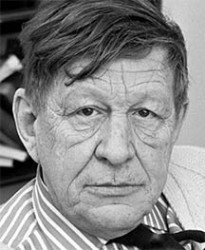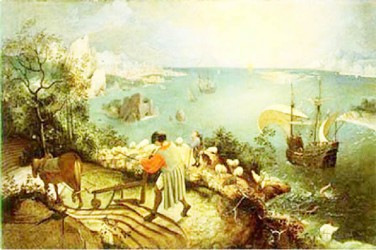In Breughel’s Icarus, for instance: how everything turns away
Quite leisurely from the disaster; the ploughman may
Have heard the splash, the forsaken cry,
But for him it was not an important failure; the sun shone
As it had to on the white legs disappearing into the green
Water; and the expensive delicate ship that must have seen
Something amazing, a boy falling out of the sky,
had somewhere to get to and sailed calmly on.
W H Auden, Museé des Beaux Arts
‘Museé des Beaux Arts’ by WH Auden is a poem about a painting. That work is Landscape With The Fall of Icarus (c1558) by Pieter Bruegel, and both painting and poem have been quite inspirational. Each is about a number of different things, but it is remarkable how the poet draws out perhaps the most remarkable feature of the painting on which to anchor his poem – a theme that quite likely was not the main focus of the painter, but which is outstandingly dramatised in the picture.


Auden was an English and American poet, born in England and graduated from Oxford (interestingly, with a third class degree) where he went to study biology but switched to English in his second year. At Oxford he was, significantly, close to well-known poets Stephen Spender, Louis MacNeice and Cecil Day Lewis. He went to the USA in 1939 and became a citizen there in 1946. However, he diquite a bit of travelling back and forth, including many visits to Europe. Among Auden’s many posts was the prestigious Oxford Professor of Poetry, 1956-1961. He was one of the outstanding twentieth century poets, (influenced by TS Eliot) and a member of that great group of modernists who revolutionised verse at that time. Poems like ‘The Death of WB Yeats’ and ‘To An Unknown Citizen’ reflect this.
Another influence on his career was socialism and radical politics to which he became quite committed at one time, and which helped shape his poetry. Many poems touch politics and he even edited a collection of Socialist Verse. He was sufficiently moved to go to Spain to join the Republican cause in the Spanish Civil War, but was starkly disillusioned by the practices of the revolutionaries he went to support.
Nevertheless, his politics is reflected in many poems, some of which are not primarily about politics. But a hallmark of truly good poets is the ease with which they treat multiple issues in a single statement. Auden treats war and different faces of politics integrated with human social issues all in the same poems. He hurls missiles at fascism and totalitarianism which were on the rise in Europe during his years of socialist commitment in artistically crafted poems such as ‘O What Is That Sound.’ Further interwoven with this are his humanist concerns and his sense of proletarian suffering as in ‘The Embassy’ and ‘The death of WB Yeats,’ while he brings war and romanticism down to earth in such works as ‘The Shield of Achilles.’
In Museé des Beaux Arts Auden is inspired by Bruegel. Pieter Bruegel the Elder (1525-1569) has been listed as both Belgian and Dutch and became a master painter in his time. His main interest was the peasantry – he researched the peasants and country life which he studied in several paintings, including ‘The Fall of Icarus,’ and was somewhat caught up in the politics of the time which included the Catholics versus the Protestants. He was famous for landscapes and the clear depiction of seasons – he has a number of winter and snow scenes. Icarus is a summer painting, which seems to dwell more on peasant life than the Greek myth from which it takes its name.

This myth is one of the innumerable tales caught up in the tangled web of stories and beliefs that make up the complex Greek mythology (religion to the ancient Athenians).
Icarus was the young son of Daedalus, a brilliant artist, inventor and craftsman. There are many versions of the story, including that recorded by the Roman poet Ovid in the Metamorphoses. To simplify it, Daedalus did a great favour for King Minos by building the Labyrinth to imprison the monster Minotaur. But he also angered the king who was a reputed ingrate and never appreciated what anyone did for him.
Minos imprisoned Daedalus and his son Icarus in a fortress on the island of Crete. In order to escape, the creative artist fashioned two pairs of wings with feathers and wax for himself and his son. When they were about to fly out of Crete, he warned Icarus not to fly too close to the sun, but the boy was adventurous and curious, and did not heed the warning. He went very high, too close to the sun whose heat melted the wax and his wings fell off. He plunged into the sea.
It is this fall that Bruegel captures in the painting. Yet, it is one of the smallest most insignificant details in the work. The picture is dominated by a landscape showing a ploughman and his horse at work in a field, a shepherd curiously gazing up at the sky while tending a large flock of sheep; a large expanse of green sea with ships sailing, and a bright glare of the flaming sun in the sky. The only hint of the fall of Icarus on the canvas is a glimpse of two white feet flailing and sinking in the water in a corner, not far from a stately ship. This brightly coloured canvas is focused in stanza two of Auden’s poem.
But it was only on reading Wikipedia that I discovered a most interesting fact. Auden’s poem is not primarily about the fall of Icarus at all; the bulk of the poem is about an entirely different painting. The whole of stanza one refers to details found elsewhere – Bruegel’s ‘The Census at Bethlehem,’ for instance. Yet, even that fits in which the very dramatic business of the poem.
Auden focuses the theme of suffering, commenting on the way it is very truthfully illustrated in the paintings by the old masters. It is a very dramatic monologue. Everything is communicated through one speaking voice – a lecturer taking his audience through a gallery and using the paintings hung on the wall to bear out his thesis. He discourses on suffering, then points out supporting details in the works. The poem is divided in two stanzas, and the break inbetween is a dramatic pause in the lecture. The speaker stops to recover his breath, probably to saunter across closer to the painting, then points directly to it – “in Bruegel’s Icarus, for instance . . .” and continues.
There is no torturer’s horse scratching “its innocent behind on a tree” in any of the paintings, but the line is meaningful. The horse is not uncaring; it really does not know, and is innocent of its master’s crimes. But it goes deeper, since the poem suggests that the horse that has carried the torturer to the place where he inflicts suffering upon others, does not care about it, and the scratching of the haunches then becomes a cold, unfeeling act by an indifferent creature.
The “innocent behind” becomes sarcasm. Stanza two interprets the painting realistically in a way that suits the poet’s purpose, but more importantly, that the poem stands independently of the painting. Its meaning is clear even to one who has not seen the painting.
Similar deliberate tension between callous indifference and oblivion, concern for other preoccupations that are necessary and must go on regardless, neatly completes the thoroughly crafted poem.





